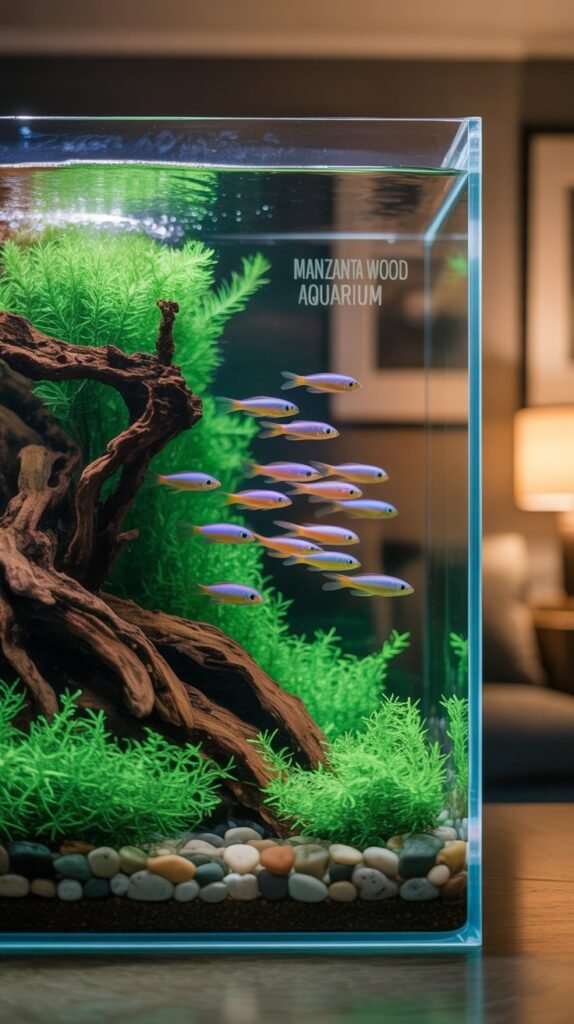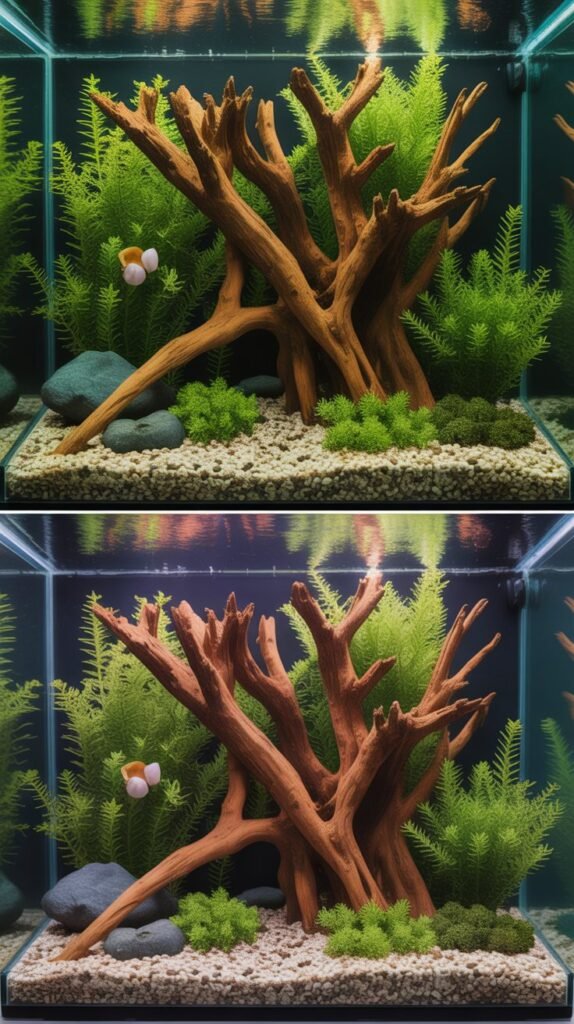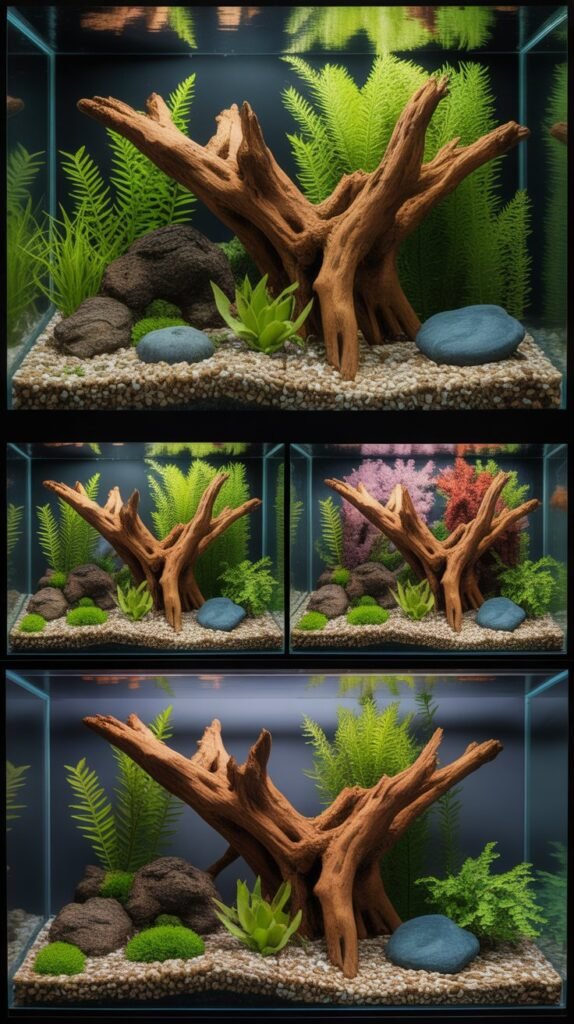When it comes to creating a stunning, natural-looking aquascape, few materials can rival the beauty and versatility of Manzanita wood. Known for its intricate branches, reddish tones, and durability underwater, Manzanita wood in aquariums has become a top choice among aquascapers, hobbyists, and professional aquarists alike.
Manzanita wood adds a unique, organic feel to both freshwater and planted aquariums. Its twisted, root-like branches mimic natural environments such as riverbanks and forest streams—offering an ideal habitat for fish, shrimp, and aquatic plants. Whether you’re creating a dramatic hardscape centerpiece or a subtle, nature-inspired layout, Manzanita wood provides endless possibilities.
In this in-depth guide, we’ll explore everything you need to know about Manzanita wood for aquariums—from its benefits and preparation process to aquascaping ideas, maintenance tips, and expert advice to help you create your dream aquascape.
What Is Manzanita Wood?
Manzanita is a type of hardwood shrub or small tree native to the western United States, particularly California, Oregon, and Arizona. The name “Manzanita” comes from the Spanish word “little apple” because of its small, red fruit.
In aquascaping, Manzanita wood is valued for its:
- Beautiful natural color: Reddish-brown to light gold hues that stand out underwater
- Unique branch shapes: Twisted, organic patterns perfect for natural layouts
- Durability: It’s extremely hard and resistant to decay, even when submerged for years
- Lightweight structure: Easier to position and combine with rocks or plants
Because of these features, it’s considered one of the best driftwoods for aquariums, rivaling Mopani, Spider, and Malaysian driftwood in both aesthetics and functionality.
Why Choose Manzanita Wood for Aquariums?

There are many types of driftwood used in aquariums, but Manzanita wood stands out due to its unique properties. Let’s look at why it’s a top-tier choice:
1. Natural Aesthetics
Manzanita wood adds an organic, wild beauty to your aquarium. Its branching structure looks like natural tree roots or branches submerged in a river—enhancing realism and depth.
2. Safe for Aquatic Life
Unlike some driftwoods that release high levels of tannins or contain toxic sap, Manzanita wood is non-toxic and safe for fish, shrimp, and snails when properly cured.
3. Minimal Tannin Release
While some driftwood types heavily darken the water, Manzanita releases only small amounts of tannins, keeping your water clearer and more visually appealing.
4. Long-Lasting Durability
This hardwood can last for years without softening or rotting. Its resilience makes it ideal for long-term aquascapes and aquariums that you don’t want to frequently redesign.
5. Versatility in Design
From minimalist Iwagumi layouts to complex jungle-style aquascapes, Manzanita wood can fit any theme. Its branches can be combined with stones, moss, or epiphyte plants for striking effects.
6. Fish and Shrimp Habitat
The branches and crevices provide excellent hiding spots, resting areas, and breeding grounds for small fish and shrimp, helping reduce stress and aggression.
Types of Manzanita Wood for Aquariums
Manzanita comes in various forms, depending on your aquascaping style and tank size:
1. Branch Manzanita
Long, thin, twisted pieces perfect for creating tree-like scapes or forest designs.
2. Trunk or Root Manzanita
Thicker, gnarled sections ideal for use as the main focal point or to create a sense of scale in larger aquariums.
3. Sandblasted Manzanita
This version is cleaned and stripped of bark, revealing a smooth, pale surface that contrasts beautifully with dark substrates and plants.
4. Natural (Unprocessed) Manzanita
Unprocessed wood retains its bark and deep color, ideal for aquarists seeking a rugged, earthy appearance.
Preparing Manzanita Wood for Aquarium Use

Before adding Manzanita wood to your aquarium, it’s essential to prepare it properly. Here’s a step-by-step process to ensure it’s safe and ready for your aquatic environment:
Step 1: Cleaning the Wood
- Scrub the wood using a brush under running water to remove dirt, insects, or debris.
- Do not use soap or chemicals, as these can harm aquatic life.
Step 2: Soaking the Wood
- Soak the wood in water for 7–14 days to help it sink naturally and release excess tannins.
- Change the soaking water every few days.
- If the wood floats, place a weight (like a rock) on it until it becomes waterlogged.
Step 3: Boiling the Wood (Optional but Recommended)
- Boiling for 1–2 hours sterilizes the wood and accelerates tannin release.
- It also helps kill any mold or pests hiding within the wood fibers.
Step 4: Testing Before Use
- After soaking, test the wood in a bucket or spare aquarium to ensure it doesn’t discolor the water significantly.
Once the wood is fully waterlogged and clean, it’s safe to add to your aquarium.
How to Use Manzanita Wood in Aquascaping
Manzanita wood is highly flexible and can be used in countless ways depending on your theme, tank size, and imagination. Here are some creative ideas:
1. Driftwood Tree Aquascape
Attach moss (like Java or Christmas moss) to the branches to simulate a lush underwater tree. This design works beautifully in nano and planted tanks.
2. Riverbank Layout
Combine Manzanita branches with river stones, gravel, and fine sand to create a flowing, natural riverbed look.
3. Jungle Aquascape
Pair Manzanita with dense background plants like Amazon Swords, Cryptocoryne, and Anubias to create a wild, overgrown jungle effect.
4. Mountain Forest Theme
Anchor thin Manzanita branches among Seiryu or Dragon stones to mimic trees growing among mountain rocks.
5. Minimalist Design
Even a single piece of Manzanita wood placed strategically can create a balanced, elegant focal point.
Best Plants to Pair with Manzanita Wood
Epiphyte and moss plants work exceptionally well with Manzanita wood since they can attach naturally without soil. Some of the best choices include:
- Java Moss (Taxiphyllum barbieri)
- Christmas Moss (Vesicularia montagnei)
- Anubias nana
- Bucephalandra species
- Java Fern (Microsorum pteropus)
- Riccia fluitans (floating or tied as carpet)
Attach these plants using cotton thread or fishing line until they root naturally onto the wood surface.
Does Manzanita Wood Affect Water Chemistry?
One of the biggest questions aquarists ask is whether Manzanita wood changes aquarium water parameters. Here’s what you need to know:
- pH Levels: Manzanita wood may slightly lower pH initially due to mild tannin release, but the effect is minimal and temporary.
- Water Hardness: No significant effect on KH or GH.
- Tannins: Releases a small amount, often giving the water a subtle amber hue that benefits blackwater species.
In short, Manzanita is stable, aquarium-safe, and won’t drastically alter water chemistry, making it suitable for most freshwater setups.
Maintaining Manzanita Wood in the Aquarium

Proper maintenance ensures your Manzanita wood remains beautiful and healthy for years:
- Clean regularly: Gently brush off algae growth during water changes.
- Avoid chemicals: Use only aquarium-safe tools and avoid bleach or soap.
- Control algae: Introduce algae eaters like Amano shrimp or Otocinclus catfish.
- Inspect for decay: Manzanita rarely rots, but always check for soft spots or mold.
- Reattach loose plants: Over time, plants might detach—tie them back if needed.
Manzanita Wood vs. Other Aquarium Woods
| Feature | Manzanita Wood | Spider Wood | Mopani Wood | Malaysian Driftwood |
|---|---|---|---|---|
| Durability | Extremely hard, long-lasting | Moderate | Very dense | Hard and durable |
| Tannin Release | Low | Moderate | High | High |
| Aesthetics | Twisted, natural branches | Root-like, complex | Smooth, dual-toned | Dark and rugged |
| Sink Time | 1–2 weeks | 1–3 weeks | Immediate | 1–2 weeks |
| Ideal For | Natural, planted, and artistic layouts | Jungle or root-style scapes | Dark, earthy tanks | Blackwater aquariums |
Manzanita wood often wins due to its balance of aesthetics, longevity, and safety.
Where to Buy Manzanita Wood for Aquariums
You can find high-quality Manzanita wood from:
- Local aquarium shops
- Online aquarium supply stores
- Aquascaping specialty retailers
- Etsy or hobbyist marketplaces
When buying online, ensure the wood is pre-cleaned, aquarium-safe, and pesticide-free. Avoid collecting wild Manzanita unless you’re certain it’s untreated and legal in your area.
How to Make Manzanita Sink Faster
Manzanita wood tends to float when first added. To make it sink quickly:
- Boil it for 1–2 hours.
- Soak in a bucket for 1–2 weeks.
- Anchor it with rocks or stainless-steel weights temporarily.
- Zip-tie it to hardscape materials until it stays submerged.
Over time, it will become fully waterlogged and naturally stay at the bottom.
Creative Aquascaping Tips Using Manzanita Wood
- Combine multiple pieces for intricate, tree-like structures.
- Use contrasting stones like Seiryu or Lava Rock to enhance depth.
- Position branches to lead the viewer’s eye toward a focal point.
- Mix sizes—thin branches with thick trunks—for a more natural look.
- Add floating plants to create light diffusion and realism.
Remember, composition and balance are key to an effective aquascape.
Common Mistakes to Avoid
- Not soaking or boiling the wood before use.
- Placing unanchored wood—it may float and disturb your layout.
- Overcrowding the tank with too many pieces.
- Using untreated or bark-covered wood without cleaning.
- Ignoring algae buildup.
Avoid these pitfalls to maintain both the beauty and safety of your aquarium.
Benefits of Using Manzanita Wood in Aquariums
- Enhances visual appeal
- Provides fish shelter and natural habitat
- Supports biofilm growth for shrimp
- Stabilizes layout structure
- Long-lasting and low-maintenance
- Encourages natural behavior in fish
- Compatible with a variety of aquascaping themes
Conclusion
Manzanita wood in aquariums is the perfect combination of beauty, functionality, and durability. Its intricate shapes, minimal tannin release, and long lifespan make it one of the most sought-after driftwoods for aquascaping enthusiasts worldwide.
Whether you’re designing a minimalist scape, a lush jungle tank, or a natural biotope, Manzanita wood can bring your underwater vision to life. With proper preparation, placement, and care, it becomes a stunning, centerpiece-worthy element that elevates the entire aquarium.
If you’re looking to create a breathtaking aquascape that’s both safe for your aquatic life and visually striking, Manzanita wood is a must-have material in your aquascaping toolkit.
FAQs About Manzanita Wood Aquarium
1. Is Manzanita wood safe for aquariums?
Yes, once cleaned and soaked properly, Manzanita wood is completely safe for all freshwater fish, shrimp, and plants.
2. How long should I soak Manzanita wood before adding it to the tank?
It’s best to soak it for at least 1–2 weeks until it becomes waterlogged and stops floating.
3. Does Manzanita wood release tannins?
Yes, but only a small amount compared to other driftwoods, resulting in minimal water discoloration.
4. Can I use Manzanita wood in saltwater aquariums?
It’s primarily used in freshwater aquariums, though some aquarists use it in marine setups after thorough curing.
5. How do I make Manzanita wood sink faster?
Boil it for 1–2 hours or weigh it down in the tank with stones or stainless-steel anchors.
6. Does Manzanita wood lower pH?
It can slightly reduce pH temporarily, but the effect is minimal and safe for most species.
7. How long does Manzanita wood last underwater?
With proper care, it can last for 5–10 years or longer without decomposing.
8. Can I attach plants to Manzanita wood?
Absolutely! Epiphyte plants like Anubias, Java Fern, and moss species attach beautifully to it.
9. Is Manzanita wood better than Spider wood?
It depends on preference—Manzanita offers a more refined, natural appearance, while Spider wood provides a root-like look.
10. Where can I buy Manzanita wood for aquariums?
You can purchase it from aquarium supply stores, aquascaping websites, or online retailers specializing in driftwood.

